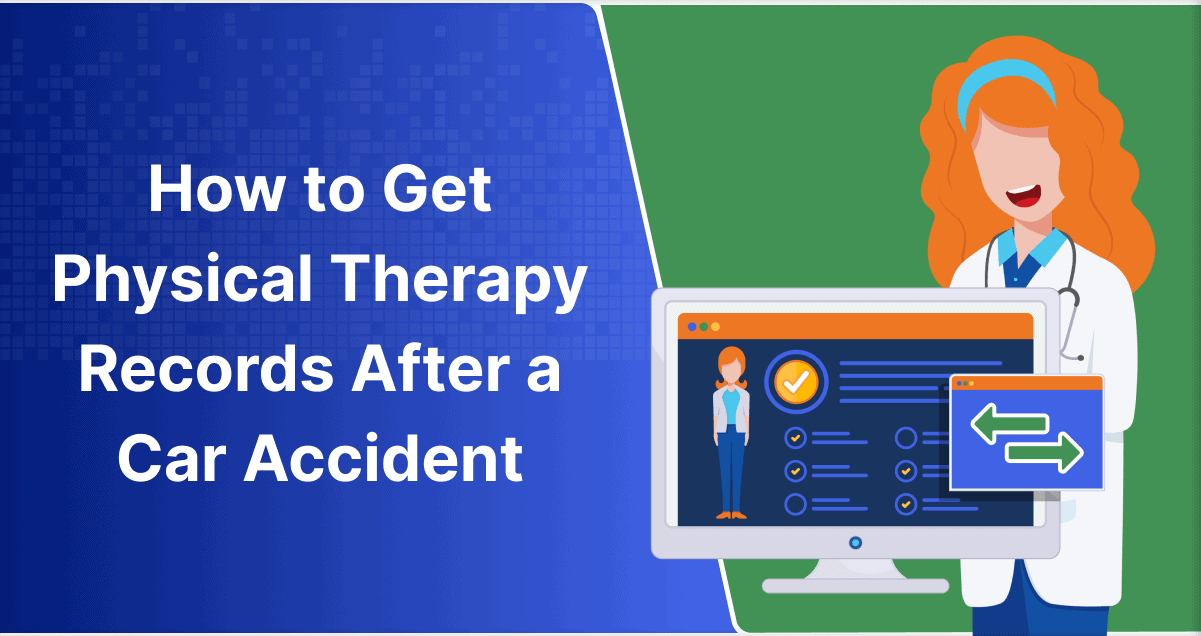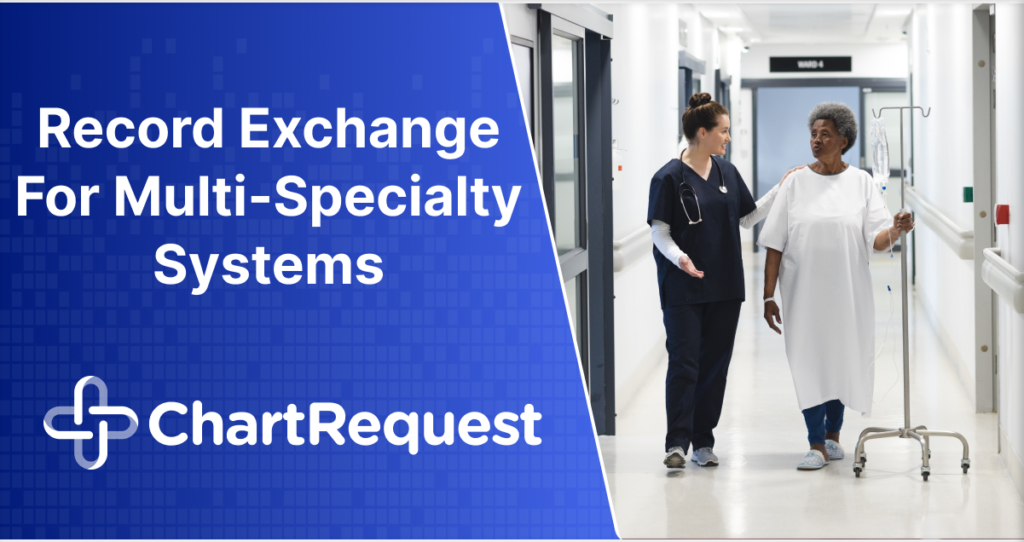Recovering from a car accident is tough, and getting into physical therapy adds to the challenge.
One important part of this is getting your medical records. These documents are key for physical therapists to create the right rehab plan for your injuries and help you heal faster.
But getting these records quickly and without hassle can be hard. There’s often a lot of paperwork and delays. Right after an accident, fast treatment is crucial, and waiting to get these records can slow down your recovery.
But is emailing medical records safe? Is the hospital going to fax your health documents? Because if they are, your protected health information could be at risk.
That’s why it’s so important to have a faster method to release medical records, including DICOM images.
Thankfully, there’s an efficient way.
In this article, we will explore how to get medical records for physical therapy after a car accident quickly and securely to make recovery less stressful for everyone involved.
Why You Need Physical Therapy After a Car Accident
Car accidents, even minor ones, can result in injuries that might not be immediately plain and visible. Physical therapy plays a key role in identifying and treating them.
Understanding the need for physical therapy after such incidents is important for complete and timely recovery.
Common Injuries from Car Accidents that May Require Physical Therapy:
- Whiplash
Whiplash is a common injury that occurs when the head is jerked forward and then backward suddenly, causing strain on the neck. It can result in neck pain, stiffness, headaches, and limited range of motion. - Head injuries
Head injuries can range from mild concussions to more severe traumatic brain injuries (TBIs). They can occur when the head strikes the steering wheel, dashboard, or windshield during a collision. Symptoms may include headaches, dizziness, confusion, memory loss, and changes in behavior or mood. - Chest injuries
Chest injuries commonly occur due to the force of impact against the steering wheel or seat belt. These injuries can include fractures of the ribs or sternum, bruised or collapsed lungs, and damage to internal organs. - Fractures and broken bones
Car accidents can result in fractures and broken bones in various parts of the body, including the arms, legs, ribs, and pelvis. The impact of the collision or being forcefully thrown against the vehicle’s interior can cause these injuries. - Spinal cord injuries
Severe car accidents can lead to spinal cord injuries, which can have long-lasting or permanent effects. These injuries can cause partial or complete paralysis, loss of sensation, and impaired bodily functions below the site of the injury. - Soft tissue injuries
Soft tissue injuries involve damage to muscles, tendons, ligaments, and other connective tissues. They can occur due to sudden jerking motions or impact during a car accident. Common soft tissue injuries include sprains, strains, and bruises. - Internal injuries
Internal injuries may not be immediately apparent but can be life-threatening. They can include damage to organs such as the liver, spleen, kidneys, or intestines. Symptoms may include abdominal pain, internal bleeding, or changes in bowel movements. - Psychological trauma
Car accidents can also result in psychological injuries, such as post-traumatic stress disorder (PTSD), anxiety, and depression. These injuries can have a significant impact on a person’s mental and emotional well-being, requiring appropriate treatment and support.
It is important to note that the severity and type of injuries sustained in a car accident that requires physical therapy can vary depending on various factors.
Role of Physical Therapy in Recovery After a Car Accident
Approximately 3 million Americans get into car accidents every year, according to the CDC.
Recovering from injuries after a bad car accident often involves physical therapy.
As a healing practice, physical therapy goes beyond mere treatment. It guides patients towards regaining their lost physical abilities and alleviating pain.
Physical therapy contributes to overall physical and mental well-being during the recovery phase.
Here are some of the roles of physical therapy during recovery:
- Pain management: Physical therapy helps in reducing pain. This helps ease discomfort associated with post-accident injuries.
- Restoring mobility and strength: This is the use of targeted exercises. therapy aids in regaining strength, flexibility, and range of motion.
- Preventing long-term damage: Regular therapy sessions can prevent chronic pain. It also helps avoid long-term disabilities arising from untreated injuries.
Physical therapy post-accident is an important step in the journey back to health and normalcy following the trauma of a car accident.
Release of Information Process for Medical Records
Obtaining physical therapy records after a car accident requires a 5-phase process called the release of information (ROI). These steps are enforced to ensure every transaction follows the HIPAA regulations that protect your PHI.
Understanding these steps can help in managing expectations and ensuring a smooth process. Here’s a breakdown of the five phases in the release of medical records:
Here’s a brief overview:
- Recording and Checking the Request:
- First, the request for your medical records is officially recorded and tracked.
- They check to make sure the request is legitimate and confirm who’s asking for the records to keep your information safe.
- Getting Your Health Information:
- After checking everything, they find and prepare the specific health records you requested.
- This step is done carefully to ensure only the needed information is accessed.
- Keeping Your Information Safe:
- It’s super important to keep your medical records private.
- During this step, they take special care to make sure your information stays secure and is handled correctly.
- Sending Out Your Records:
- Your medical records are now sent to the person or organization that requested them.
- Finishing Up and Invoicing:
- Lastly, they close out your request in their system, marking it as done.
- If there are any costs for getting and sending your records, they’ll prepare a bill for these. Usually, medical records copying fees differ from state to state.
Each of these steps makes sure that your medical records are handled in a secure and careful way.
This overview gives insight into the main steps of requesting medical records. Challenges still occasionally arise that interrupt progress. This is where services like ChartRequest make the difference.
Obtaining physical therapy records after a car accident the traditional way can take weeks, but ChartRequest processes medical records requests in just days.
Why Accessing Your Medical Records Quickly is Important
Fast access to medical records is vital for an efficient healthcare system. It helps doctors and nurses make smart choices, figure out what’s wrong, and plan the best treatment for each person, including physical therapy.
When healthcare providers can get records quickly, they can give better and faster care. This leads to patients getting better sooner and improves the whole healthcare experience.
Here are the benefits of fast access to health records:
- Faster diagnosis and early treatment
Physical therapists must know about your past and current health to help you properly. Getting medical records quickly means they can figure out the extent of injuries you suffered after the accident. They can start the right treatment sooner, stopping health problems from worsening. - Better healing
If therapists can see your medical history immediately, they can tailor treatment plans. This usually means you get better quicker and more effectively. - Working together for better care
Often, you will see several different healthcare experts. Having medical records easy to access means everyone involved in your care can work better together. - Helps with legal and insurance process
Insurance or any other legal matters proceed faster when medical records are easy to access. - Saves time for healthcare workers
Faster release of information turnaround times decrease administrative burdens and help healthcare providers focus more on patient care. - Patients feel better about their care
you feel more secure and confident with your treatment plan when you can access your medical records.
ChartRequest: Simplifying the Medical Records Retrieval Process
ChartRequest is revolutionizing the healthcare industry by streamlining the medical records retrieval process. As an ROI platform, it’s a modern alternative to the complex, traditional process of requesting documents.
With ChartRequest, the once time-intensive task is now an efficient and smooth operation. This brings several benefits to healthcare providers and patients alike.
Let’s delve into the specifics of how ChartRequest makes it easy to get physical therapy records after a car accident:
Key Features of ChartRequest:
- Automated Request Tracking
The platform provides real-time updates on the status of medical record requests. We maintain transparency and communication between requesters and providers this way. - Robust Security and Compliance
Complying with HIPAA regulations is at the core of our everyday operations. ChartRequest assures patient data security and confidentiality by ensuring all end-to-end transactions are always encrypted. - Flexible Service Options
Catering to diverse healthcare requirements, ChartRequest offers both self-service and full-service options. This allows providers to select a model that aligns with their operational workflow. Patients can also request records through ChartRequest on their own.
Benefits for Healthcare Providers:
- Operational efficiency: Automating the record retrieval process significantly cuts down on time. This reduces the administrative load on healthcare staff.
- Enhanced care coordination: Rapid access to complete medical records fosters improved collaboration among healthcare professionals. This results in more effective patient care.
- Error reduction: The platform’s precision in managing requests minimizes the likelihood of errors. This reduces the common issue in manual handling.
- Easy to use: ChartRequest has modernized the method of accessing and sharing medical records. Its intuitive design significantly reduces bureaucratic processes and excessive paperwork, leading to a more expedient and streamlined approach.
9 Ways ChartRequest Ensures HIPAA Compliance
ChartRequest does not just comply with HIPAA–we know it like the back of our hands.
Our expertise in managing health information focuses on keeping patient data safe and private.
ChartRequest ensures that patients’ health details are kept confidential by using strong security steps and careful privacy practices. This careful approach is especially important when they handle the release of medical information.
Here’s how we do it:
- Data Encryption: ChartRequest utilizes robust encryption to protect data during transmission and storage. This ensures that any health information sent or stored is encrypted.
- Access Controls: We implement strict access controls so only authorized personnel can access sensitive health information. This includes role-based access, which ensures that individuals have access only to the information necessary for their job functions.
- Audit Trails: ChartRequest maintains detailed audit trails. We keep logs of who accessed what information and when. This is crucial for tracking access to sensitive information and investigating potential breaches.
- Secure User Authentication: We employ strong user authentication measures throughout the platform. This includes multi-factor authentication. It adds a layer of security beyond just usernames and passwords.
- Regular Training and Awareness: We regularly train our staff on HIPAA regulations. They know the importance of protecting patient information, which is crucial for maintaining compliance.
- Business Associate Agreements (BAAs): As a business associate of healthcare providers, ChartRequest signs Business Associate Agreements (BAAs) with clients.
- Regular Security Assessments and Compliance Audits: Conducting regular security assessments and compliance audits helps ChartRequest identify and mitigate potential vulnerabilities.
- Incident Response Plan: A robust incident response plan is crucial in a data breach or other security incident. This plan should include procedures for responding to the incident, mitigating harm, and notifying affected parties as HIPAA requires.
- Patient Rights Compliance: ChartRequest ensures compliance with patient rights as outlined in HIPAA. We make sure to include the right to access their health information and the right to request amendments to their records.
Get Physical Therapy Records After a Car Accident Faster
ChartRequest is a key resource for healthcare professionals and patients who need a streamlined and secure approach to handling medical records.
We simplify the process of exchanging records, saving valuable time and enhancing patient care. Our HIPAA compliance is up-to-date and reflected in our processes and security. We are here to ensure the utmost protection of patient information and build trust in healthcare practices.
Our platform is designed to be user-friendly, so all types of requestors can easily use it. Our robust security features mean every transaction is protected.
This makes ChartRequest highly suitable for the demands of modern healthcare settings. Whether you want to keep a personal record or it’s for your physical therapy, you can access it faster using ChartRequest.
For healthcare professionals who want to improve how they work and provide better care to patients, using ChartRequest is a smart choice.
ChartRequest is designed to meet modern healthcare facilities’ changing needs for managing health information. By integrating ChartRequest into their workflow, healthcare professionals can streamline their processes and improve patient outcomes. This makes ChartRequest a leading solution for health information management.









